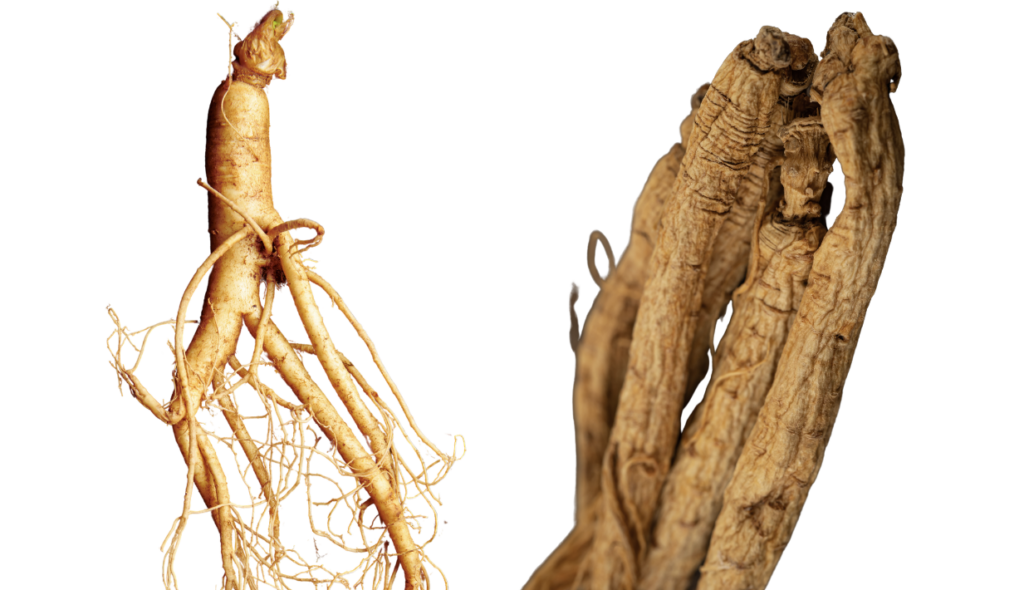Supplements and Herbs
Red ginseng VS. White ginseng
Ginseng, which comes from the Panax ginseng plant, is a well-known and respected herb that has been used in traditional treatment for hundreds of years. It is widely used as a plant supplement and is known to have many health benefits. A lot of different kinds of ginseng are out there, but the most popular ones are red and white. Even though they both come from the same plant, the way they are processed makes them different in terms of their properties, strength, and intended uses. This article will talk about the differences between red and white ginseng, including how they are processed, how they affect the body, and whether they might be good for your health.
Processing Methods: Steaming vs. Drying
Most of the differences between red and white ginseng come from the different ways they are processed. Green ginseng is made by heating the fresh ginseng roots, while white ginseng is made by drying them. Each type of ginseng has its benefits and qualities that come from the different ways it is processed.

Red Ginseng: Potent and Energizing
Red ginseng is steamed, which involves exposing fresh ginseng roots to high temperatures. This steaming technique turns the roots reddish-brown and helps to retain and improve the medicinal components found in ginseng, such as ginsenosides. Ginsenosides are thought to be responsible for many of the health advantages of ginseng.
The steaming technique utilized in the manufacturing of red ginseng not only preserves but also raises the concentration of medicinal components. As a result, red ginseng is thought to be more potent and invigorating than white ginseng. It is frequently used to stimulate physical and mental performance, the immune system, and sexual function.

White Ginseng: Calming and Relaxing
White ginseng, on the other hand, is made by drying fresh ginseng roots in the sun or in a low-temperature oven. The roots turn a light, yellowish-white tint as a result of the drying process. While white ginseng has a gentler flavor and aroma than red ginseng, it is less strong.
White ginseng is popular for its calming and relaxing properties. It is thought to help with stress reduction, cognitive function, and overall well-being. White ginseng’s gentler nature makes it a better choice for people who are sensitive to the stronger effects of red ginseng.

Health Benefits of Red Ginseng and White Ginseng
While there are many health benefits to both red and white ginseng, the precise effects may differ owing to processing changes and potency. In this article, we will explore the possible advantages of every variety of ginseng.
Red Ginseng Benefits
With more active components, red ginseng has potent health benefits. Key red ginseng health advantages include:
1. Enhanced Physical and Mental Performance
Athletes and fitness enthusiasts utilize red ginseng. It may boost stamina and vitality. Red ginseng may also boost concentration, focus, and cognition.
2. Boosted Immune System
Traditional uses of red ginseng include immune system boost and illness prevention. It may boost immune cell formation and activity, boosting the body’s defenses.
3. Improved Sexual Function
Red ginseng has long been used to boost libido and sexual function. It may improve erectile dysfunction, sperm count, and sexual health.
4. Antioxidant and Anti-inflammatory Effects
Red ginseng has antioxidant and anti-inflammatory substances. These qualities reduce oxidative stress and inflammation, which may prevent chronic diseases and improve health.
White Ginseng Benefits
Even though white ginseng is thought to be less powerful than red ginseng, it still provides a variety of advantages to both health and wellness. Several potential advantages that are related to white ginseng include the following:
1. Stress Reduction and Relaxation
People often use white ginseng because it can calm and relax them. While it may help ease stress and worry, it may also help you feel more calm. Because it is not as strong as red ginseng, white ginseng is better for people who are more sensitive to its stimulating effects.
2. Cognitive Function Improvement
Researchers have looked into whether white ginseng can help people think more clearly. It might help with memory, concentration, and brain performance in general. White ginseng may help keep your brain healthy and improve your mental ability if you take it regularly.
3. Overall Well-being
People think that white ginseng can improve their overall health and energy. It might help give you more energy, make digestion better, and keep your body’s natural balance. White ginseng may help you feel healthier and more energized if you take it regularly.
Conclusion
As I try to figure out how to choose between Red Ginseng and White Ginseng, I want to give my readers some personal advice: be mindful as you start your plant journey. Before picking between the strong energy boost of Red Ginseng and the wide range of benefits of White Ginseng, think about your own health goals, way of life, and personal tastes. Experimenting is important. Try different amounts, blends, and types to see what works best for your body. It’s important to talk to a doctor or nurse to make sure that the type of ginseng you choose is safe for your health, especially if you already have health problems or are taking medicine. Enjoy the variety that these types of ginseng offer on your path to health, and may your choices lead you to a road of balance and vitality.


